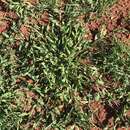Global Distribution
provided by Bibliotheca Alexandrina LifeDesk
Mediterranean region, southwards to south Africa and eastwards to India.
- author
- BA Cultnat
- provider
- Bibliotheca Alexandrina
Comments
provided by eFloras
This is the only species of
Brachiaria occurring in China with a fertile floret which is shed from the mature spikelet. The fertile floret is also distinctive due to its smooth, glossy texture and obtuse apex.
This species and two close relatives in Africa have been placed in the separate genus Moorochloa Veldkamp.
- license
- cc-by-nc-sa-3.0
- copyright
- Missouri Botanical Garden, 4344 Shaw Boulevard, St. Louis, MO, 63110 USA
Description
provided by eFloras
Annual. Culms loosely tufted, slender, much branched, geniculately ascending, 30–40 cm tall, nodes softly hairy. Leaf sheaths glabrous or loosely tuberculate-hairy; leaf blades linear-lanceolate, 1.5–10.5 × 0.3–0.6 cm, glabrous or pilose; ligule ciliate. Inflorescence axis 3–6 cm; racemes 4–10, 1–3 cm, erect or narrowly ascending; rachis narrow, triquetrous, ciliate or scabrous; spikelets single, in 2 rows, overlapping. Spikelets elliptic, 1.8–3 mm, pilose, subacute; lower glume 0.2–0.3 mm, membranous, glabrous; upper glume and lower lemma as long as spikelet, 5-veined; upper floret readily deciduous, oblong, ca. 1.5 mm, thinly crustaceous, smooth, glossy, apex obtuse. Fl. and fr. summer–autumn. 2n = 18.
- license
- cc-by-nc-sa-3.0
- copyright
- Missouri Botanical Garden, 4344 Shaw Boulevard, St. Louis, MO, 63110 USA
Description
provided by eFloras
Loosely tufted annual; culms 10-60 cm high, slender, geniculately ascending. Leaf-blades linear to narrowly lanceolate, 2-8 cm long, 2-5 mm wide, glabrous or pubescent. Inflorescence of 3-12 racemes on an axis 1-6 cm long; racemes 0.5-2.5 cm long, secund, bearing single spikelets imbricate on a triquetrous rhachis. Spikelets elliptic, 1.7-2.7 mm long, pubescent (rarely glabrous or villous), sub-acute; lower glume a minute scale 0.2-0.5 mm long (up to a fifth the length of the spikelet); upper lemma readily deciduous, smooth, shiny, obtuse.
- license
- cc-by-nc-sa-3.0
- copyright
- Missouri Botanical Garden, 4344 Shaw Boulevard, St. Louis, MO, 63110 USA
Distribution
provided by eFloras
Distribution: Pakistan (Sind, Baluchistan, Punjab, N.W.F.P. & Kashmir); South Africa to the Mediterranean; eastwards to India.
- license
- cc-by-nc-sa-3.0
- copyright
- Missouri Botanical Garden, 4344 Shaw Boulevard, St. Louis, MO, 63110 USA
Habitat & Distribution
provided by eFloras
Open and disturbed situations on hill slopes and in dry fields as an arable weed. Fujian, Guizhou, Yunnan [India, Malaysia, Thailand; N Africa, Mediterranean region].
- license
- cc-by-nc-sa-3.0
- copyright
- Missouri Botanical Garden, 4344 Shaw Boulevard, St. Louis, MO, 63110 USA
Synonym
provided by eFloras
Panicum eruciforme Smith in Sibthorp & Smith, Fl. Graeca 1: 44, t. 59. 1806; Brachiaria isachne (Roth ex Roemer & Schultes) Stapf; Echinochloa eruciformis (Smith) Koch; Moorochloa eruciformis (Smith) Veldkamp; P. caucasicum Trinius; P. isachne Roth ex Roemer & Schultes.
- license
- cc-by-nc-sa-3.0
- copyright
- Missouri Botanical Garden, 4344 Shaw Boulevard, St. Louis, MO, 63110 USA
Physical Description
provided by USDA PLANTS text
Annuals, Terrestrial, not aquatic, Stolons or runners present, Stems trailing, spreading or prostrate, Stems nodes swollen or brittle, Stems geniculate, decumbent, or lax, sometimes rooting at nodes, Stems mat or turf forming, Stems caespitose, tufted, or clustered, Stems terete, round in cross section, or polygonal, Stem nodes bearded or hairy, Stem internodes hollow, Stems with inflorescence less than 1 m tall, Stems, culms, or scapes exceeding basal leaves, Leaves mostly cauline, Leaves conspicuously 2-ranked, distichous, Leaves sheathing at base, Leaf sheath mostly open, or loose, Leaf sheath smooth, glabrous, Leaf sheath hairy, hispid or prickly, Leaf sheath hairy at summit, throat, or collar, Leaf sheath and blade differentiated, Leaf blades linear, Leaf blades lanceolate, Leaf blades 2-10 mm wide, Leaf blades mostly flat, Leaf blades mostly glabrous, Leaf blades more or less hairy, Ligule present, Ligule a fringed, ciliate, or lobed membrane, Inflorescence terminal, Inflorescence an open panicle, openly paniculate, branches spreading, Inflorescence a contracted panicle, narrowly paniculate, branches appressed or ascending, Inflorescence solitary, with 1 spike, fascicle, glomerule, head, or cluster per stem or culm, Inflorescence a panicle with narrowly racemose or spicate branches, Inflorescence with 2-10 branches, Inflorescence branches 1-sided, Rachis angular, Flowers bisexual, Spikelets sessile or subsessile, Spikelets dorsally compressed or terete, Spikelet less than 3 mm wide, Spikelets with 1 fertile floret, Spikelets with 2 florets, Spikelets solitary at rachis nodes, Spikelets all alike and fertille, Spikelets bisexual, Spikelets disarticulating below the glumes, Spikelets secund, in rows on one side of rachis, Rachilla or pedicel glabrous, Glumes present, empty bracts, Glumes 2 clearly present, Glumes distinctly unequal, Glumes shorter than adjacent lemma, Glumes equal to or longer than adjacent lemma, Glume equal to or longer than spikelet, Lemma similar in texture to glumes, Lemma 5-7 nerved, Lemma glabrous, Lemma apex truncate, rounded, or obtuse, Lemma awnless, Lemma margins thin, lying flat, Lemma straight, Palea present, well developed, Palea membranous, hyaline, Palea about equal to lemma, Stamens 3, Styles 2-fid, deeply 2-branched, Stigmas 2, Fruit - caryopsis, Caryopsis ellipsoid, longitudinally grooved, hilum long-linear.

